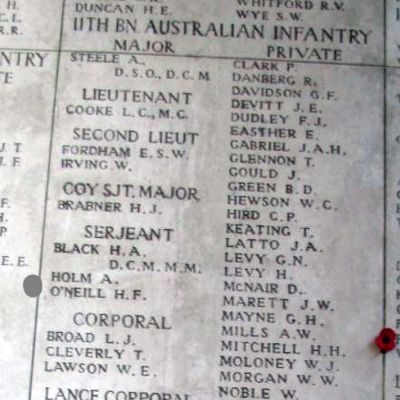Difference between revisions of "Herbert Frank O'Neill"
From Our Contribution
| Line 78: | Line 78: | ||
| label22 = Monument | | label22 = Monument | ||
| − | | data22 = [[Serpentine]] | + | | data22 = [[Serpentine Roll of Honour]] |
| label23 = Medals | | label23 = Medals | ||
Revision as of 13:19, 7 November 2017
 | |
| Personal Information | |
|---|---|
| Date of Birth | 19 Feb 1882 |
| Place of Birth | Cambridge, Auckland, New Zealand |
| Death | 21 Sep 1917 |
| Place of Death | Belgium |
| Age at Enlistment | 32 years, 6 months |
| Occupation | surveyor's assistant |
| Religion | Roman Catholic |
| Address | 'Perringa Grove', Serpentine, Western Australia |
| Next of Kin | Mother Mrs F O'Neill |
| Military Information | |
| Reg Number | 932 |
| Date of Enlistment | 7 Sep 1914 |
| Rank | Sergeant |
| Unit/Formation | 11th Battalion, 16 Platoon, D Company |
| Date of Embarkation | 2 Nov 1914 - 5 Dec 1914 |
| Ship Embarked On | HMAT A11 Ascanius |
| Fate |
Wounded in Action 28 Apr 1915 Gallipoli Wounded in Action 22-26 Jul 1916 Poziéres Killed in Action 21 Sep 1917 Menin Road |
| Monument | Serpentine Roll of Honour |
| Medals |
1914-1915 Star British War Medal Victory Medal |
Contents
Pre War
It would appear that prior to coming to Australia, O'Neill was married. Wife's name was Mary Jane O'Neill Had prior service with the 8th New Zealanders in South Africa.
War Service
Enroute to Egypt they stopped at Colombo on 15 Nov 1914, Aden on 25 Nov 1914, and Suez on 30 Nov 1914 before arriving in Alexandria on 5 Dec 1914. Entrained, they travelled to Mena Camp near Cairo where they spent several months completing their training. On 1 Mar 1915 he embarked on HMAT A23 Suffolk to join the Gallipoli campaign, and sailed the next day for Lemnos Island, arriving in the afternoon of 4 Mar 1915. As a member of the 11th Battalion he was one of the first ashore at Anzac Cove early on 25 Apr 1915, landing from the Suffolk around 4:30am under heavy rifle and machine gun fire. Early success was achieved as they scaled the cliffs (about 90m tall) and pushed inland. Herbert was wounded (described as slight) on the 28th, but was evacuated on the HMT Galeka, arriving in Alexandria on 2 May 1915. From Alexandria he was transported to England where on 16 May he entered the No 1 Southern General Hospital in Birmingham. On recovering he was sent to Weymouth before being sent back to Gallipoli as a reinforcement, rejoining 11th Battalion on 6 Sep 1915.
Evacuated from the Gallipoli Peninsula to Mudros Harbour on Lemnos in late Dec 1915, he then embarked on the HMT Empress of Britain for Alexandria, arriving on 7 Jan 1916.
At Serapeum on 1 Mar 1916 he was appointed Lance Corporal, and on 29 Mar 1916 he embarked on HMT Corsican for Marseilles, arriving there on 5 Apr 1916. In France on 1 May 1916 he was promoted temporary Corporal, with the rank being confirmed on 12 May 1916.
Wounded during the attack on Poziéres with wounds to the left leg and shoulder. Seen by the 2nd Field Ambulance on 24 Jul 1916 we can assume that the injury was received in the earlier stage of the battle when D Company was part of the first wave of attack that sustained some casualties during the attack, and more when they ran into the friendly barrage that was firing on the second stage targets. Once the Field Ambulance had finished with him, he was passed on to the 3rd Casualty Clearing Station, and on 26 Jul 1916 he was safely in the 1st Australian General Hospital at Rouen.
Three days later i.e. 29 Jul 1916 he was embarked on HMHS Marama in Le Havre for England where on 30 Jul 1916 he was admitted to the 3rd Western General Hospital in Newport, Wales with a shell wound to his left thigh. From 1 - 16 Sep 1916 he was granted furlough, before on 29 Sep 1916 he once again proceeded overseas to France, and was able to rejoin his battalion in the field on 16 Oct 1916. On 25 Oct 1916 he was promoted Sergeant, before a month later on 27 Oct 1916 reporting to the 2nd Australian Field Ambulance with complications from is previously wounded thigh. Despatched to the New Zealand Stationary Hospital in Amiens, he was next seen by the 2nd Australian General Hospital who evacuated him to England aboard HMHS St David on 2 Dec 1916 from Boulogne.
In England he was again admitted to the 3rd Western General Hospital in Newport, Wales on 3 Dec 1916. On 28 Dec 1916 he was transferred to the 2nd Auxiliary Hospital where he was granted furlough from 30 Dec 1916. For the next six months he was based at the No1 Command Depot at Perham Downs before proceeding overseas to France again on 6 Aug 1917, and 12 days later he was back with the 11th Battalion.
Initially reported as wounded, and missing in action on 21 Sep 1917, this was later amended in November to him having been Killed in Action on 21 Sep 1917. The unit War Diary on the other hand speaks of heavy contact with the enemy on the 20th in Polygon Wood, with casualties taken, and on 21st their withdrawal from the front lines.
Casualty List 370 published by the West Australian on 15 Dec 1917 advised this change of status.
Notes

